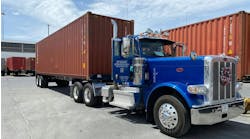The storm of issues that have been building around engine idling reached hurricane strength last month when hundreds of scientists from around the world issued their report on global climate change. Earth, it seems, is in big trouble and most of it is due to the emissions from burning fossil fuels.
According to the Intergovernmental Panel on Climate Change, “more likely than not” the droughts, tidal surges, heat waves, torrential rains and city-smashing hurricanes of recent months are the result of global warming caused primarily by the carbon-dioxide humans have been pumping into the atmosphere for decades. Even if emissions level off immediately, the catalog of potential future consequences is long and sobering and stretches ahead for centuries to come.
TIME TO QUIT
Whether you buy into the panel's new forecast or not, the plain fact is that engine idling has escalated, virtually overnight, from a “simple” matter of wasting fuel, squandering profit, violating regulations and endangering the public health to something graver still. For fleets that have yet to implement an idle reduction solution, it is clearly time to quit idling now while the quitting is good, while you can select the choice that best suits your operation and enjoy a long list of benefits — beginning right now.
In addition to saving money on fuel and vehicle maintenance, reducing exposure to idling fines and penalties, and boosting tractor resale value, implementing an idle reduction system now can also help keep drivers comfortable and fleet images positive. According to some of the scientists involved in writing the report on climate change, significantly scaling back emissions soon enough may also improve the outlook for life on earth within the next 30 to 50 years.
“Even before the report on climate change, we were seeing a growing awareness and sophistication in the marketplace,” notes Eduardo Andrade, business manager, special products for the Truck/Trailer Products Group of Carrier Transicold, supplier of the ComfortPro idle reduction system (www.trucktrailer.carrier.com).
“When diesel began pushing past $3.00 a gallon, the initial reaction was, ‘I have to buy an APU [auxiliary power unit] to save money on fuel,’ ” he says. “Now, fleets and owner-operators are looking at the whole picture and taking things like component life, maintenance costs, resale value, regulatory compliance, driver retention, company image and environmental impacts into consideration.”
“We see three basic drivers in the idle reduction systems market, economic, legal and environmental,” says Chris Baldwin, director of the RV/mobile strategic business unit for the Kohler Company (www.kohler.com), which will be offering an APU system of its own beginning this spring. “The result is an increasing rate of adoption for idle reduction systems and a growing market over all.”
MAKING THE RIGHT CHOICE
While there are plenty of reasons to reduce engine idling and more than 40 system choices, that doesn't make the decision process itself any easier. During a panel presentation for the Truckload Carriers Association Refrigerated Division Conference last summer, Martin Duffy, Western regional director for ThermoKing Corp., which makes the TriPak APU, (www.therm-oking.com) and Eduardo Andrade of Carrier Transicold, supplier of the ComfortPro APU, offered step-by-step guidelines for selecting an idle reduction solution. Their complete presentations are available on the TCA Web site: www.truckload.org.
According to Duffy, the first step is to ask a series of clarifying questions about your idling practices and policies now and your goals in implementing an idle reduction system. Answers to these questions can help you narrow your list to only those systems that will meet your needs and expectations:
-
What is the primary driver behind your interest in an idle reduction solution? Is it fuel prices? Legislative pressure and compliance? Concern for the environment? The availability of rebates or grant money? A desire to make the best use of available capital? Driver retention? Or some mix of all of these factors?
-
What functions do current fleet idling policies support? Providing driver safety and comfort? Engine block heating? Other?
-
How long do drivers typically idle?
-
What is the mix of ambient conditions in which trucks operate? Varying? Primarily hot? Primarily cold? Primarily mild?
-
Where and when will you require parts and service support?
-
Where do your drivers park for rest stops? Always at the same locations or does it vary?
-
What is your tractor trade cycle? This will help you accurately calculate the cost savings realized from idle reduction versus the capital expenditure required upfront.
-
Will the idle reduction solution become a factor in your driver recruiting and retention efforts? How will you use it?
Once you have identified a potential solution, doing a good economic review is the final part of the decision-making process. According to Andrade, here are the basic steps in the financial analysis:
-
Determine your operating profile, including miles traveled per year, average speed, percentage of idle time, operating days per year and trade cycle. Translate that into engine rolling hours, total hours and idle hours.
-
Determine your main engine's true fuel consumption at idle by conducting your own fuel consumption tests. Do at least three tests and average the results. (There is an SAE test procedure available to guide you through the process.)
-
Once you know your actual average gallons of fuel burned per hour at idle, calculate the fuel cost for idling per hour, year, and the total trade cycle by multiplying out gallons per hour times fuel cost per gallon.
-
Compare the hourly fuel costs for operating the truck's main engine at idle versus using an APU or some other idle reduction system instead to arrive at a net cost savings per hour.
-
Compare the other relevant factors that will impact your ROI, including the maintenance savings associated with reducing the wear idling causes to the truck's engine, possible savings available from extending drain intervals, engine life extension and the possibly higher resale value for an idle reduction-equipped truck versus the additional costs of maintaining an idle reduction solution.
WHAT NEXT?
One of the concerns that can keep companies (or individuals) from taking action is the nagging feeling that as soon as they spend the time and money to implement Solution A, an even better Solution B will come out, eclipsing everything that came before. So where are idle reduction systems and practices headed in the future?
“I think that diesel engines will eventually be replaced by batteries as the power source for idle reduction systems and then perhaps by fuel cells of some sort after that,” predicts Joseph D. Tario, project manager transportation and power systems research for NYSERDA (the New York State Energy Research and Development Authority) (www.nyserda.org). “Since we now have the ability to track vehicles and report on emissions by location, that makes things like getting and trading carbon credits for reducing emissions a good possibility for fleets as well as stationary businesses, such as truck stops. That could give fleets and others an additional incentive to reduce idling and accelerate the pace of R&D.”
“I totally agree with Joe Tario's view of the evolution of idle reduction systems,” says Bruce T. Davis, transportation enterprise systems solutions market development director for Flying J, Inc., which markets an APU called the Flying J Cab Comfort System (www.fjesolutions.com). “We feel fortunate to be well-positioned to take advantage of new idle reduction technologies as they emerge.
Idling is an issue not only for trucking, but also for the railroads, the marine industry, heavy equipment, airlines, even home equipment such as lawnmowers,” he adds. “I think there is no question we will see more idling regulations and stricter limits.”
“Along with the increase in idling regulations, it would be nice to see more funding for R&D and for end-users,” offers Doug Lentz, director of transportation product management for ThermoKing Corp. “That could certainly accelerate development and deployment. In the short term, however, we expect to see continued refinement of the diesel-powered APU. It will probably be sometime after 2010 before non-diesel power is a significantly larger part of the idle reduction business.”
“North America will probably follow Europe in its approach to idle reduction,” says Don Kanneth, general manager, Heavy-Duty Division for Webasto Product North America, Inc., which offers Air Top brand fuel-fired heaters and a cooling solution called BlueCool Truck (www.webasto-us.com). “In Europe, truck manufacturers have been installing idle reduction systems for some time now. Much higher fuel costs have made idle reduction a priority. We are already participating in work in northern Germany to develop new power sources for idle reduction systems, including solid oxide fuel cells.”
“Ultimately, I have always believed there would someday be a system for running all necessary functions when the truck is stopped,” observes Rex Greer, president of Pony Pack, Inc., a pioneer in the manufacture of APUs (www.ponypack.com). “Because of the nature of trucking, I think that will have to be an onboard solution for everybody. Eventually, such systems will just be part of every new truck.”
Financial incentives
“What I'd really like to know, is what are they waiting for? What is keeping people from buying an idle reduction solution now and enjoying the cost savings?” an APU supplier asked the other day. “Do people want more benefits? More functionality? Are they just waiting for a better mousetrap? What?”
The chief obstacle for some carriers has been up-front cost. Even with speedy payback periods and the prospect of a positive cash flow virtually from day one, the capital to purchase and install idle reduction systems still has to come from somewhere. Today there are numerous state and federal programs to help companies implement idle reduction solutions, from loans to grants and tax credits.
MORE FROM OR
One initiative that is garnering a lot of national attention is Cascade Sierra Solutions. (www.cascadesierrasolutions.org). Headed by CEO, Sharon Banks, the organization was founded to help smaller fleets and owner operators improve their fuel efficiency and reduce emissions by installing idle reduction systems and other fuel-conserving components, such as low rolling resistance tires, aerodynamic devices and lighter weight components.
At Cascade Sierra Solutions' new “outreach center” at the TravelCenters of America travel plaza in Coburg, OR, interested drivers and fleet owners can see about forty different idle reduction systems on display and get personal help deciding which best fits their operation and their budget. Even better, the organization offers installation through a dealer network and two financing options: a lease and buy-back program for Oregon-based companies and a Small Business Loan for small fleets, regardless of their location.
“We have close to forty different products in the shop now,” says Banks. “It really helps to break down the awareness barrier. It is also helpful to be able to look at so many options side-by-side in an unbiased environment. We can help companies compare costs, determine a budget and make choices about what is most appropriate for their operation.
“The idle reduction systems financing program for qualifying Oregon companies is a no money down, five-year lease with a $10 buy-back after that,” she explains. “The interest rate is seven percent plus a small risk amount. Payments are usually in the $180 to $230 per month range.
“Through the EPA's Small Business Administration loan program, small trucking firms can borrow from $5,000 to $25,000 to help them purchase EPA SmartWay Upgrade Kits,” Banks continues. “There is a packaging fee of $450, but the loans require no collateral, allow up to ten years to pay and there is no prepayment penalty. We can even take applications over the telephone. Between January 1 and February 5, we received 49 applications. Nine have been processed already and about 30 more are right behind.” The SmartWay Upgrade Kits include idle-reduction systems, low rolling resistance tires, aerodynamic equipment and exhaust aftertreatment devices, according to Banks, and fleets may opt to purchase some or all of the elements.
Companies for which neither financing option is appropriate may still be eligible for financial support through other grant or tax credit programs. Cascade Sierra Solutions will also provide help applying for California's Carl Moyer program (www.baaqmd.gov/pln/grants_and_incentives/carl_moyer/index.htm) or for Oregon's tax credit program.
“The thing about the Upgrade Kits is that companies can see a positive cash flow immediately,” says Banks. “Net savings of $400 to $500 per month per vehicle are typical with the installation of an idle reduction system alone. If you add the other kit elements, savings can be as much as $1,000 per month.”
According to Banks, the center gets lots of requests to open similar facilities in other locations. The next one, however, is already planned for Sacramento.
OTHER STATE PROGRAMS
Oregon is not the only state offering financial support to carriers for reducing truck emissions. A list of state-level programs is available on the U.S. Department of Energy Web site at www.eere.energy.gov. The site also includes information about idling regulations and fines.
For example, in addition to the Carl Moyer program, California offers other idle reduction grants, including the Heavy-Duty Engine Idle Reduction Incentive program that provides incentive funds for technologies “that result in a significant reduction of on- and -off road heavy-duty vehicle idling in the San Joaquin Valley.”
Through the Department of Environmental Quality, Arkansas has a small business loan program designed to provide low-interest loans to Arkansas-based small businesses to institute pollution control measures. Idle reduction technologies for heavy-duty trucking operations are eligible for this loan. North Carolina also has funding available for implementing idle reduction programs, as does Ohio, Pennsylvania and Wisconsin.
FEDERAL INCENTIVES
The list is also long and growing longer of federal programs designed to help reduce fuel consumption and vehicle emissions. The U.S. Department of Energy (DOE), Department of Transportation (DOT), and Environmental Protection Agency (EPA) all administer a variety of programs, typically making funds available through initiatives managed by states, universities and other agencies rather than directly to individual businesses.
For example, the DOT has several financial assistance and innovative finance programs, including for idle reduction projects. One such funding source is the Congestion Mitigation and Air Quality Improvement (CMAQ) program which provides funds to state DOTs, metropolitan planning organizations and transit agencies to invest in projects to reduce transportation-related pollution.
The EPA also issues grants to states and nonprofit groups for idle reduction. In September 2006, for instance, the agency awarded $2.1 million in grants for New Jersey's efforts to reduce emissions from diesel engines, including $750,000 to fund the purchase of alternative energy sources and equipment to reduce idling.
The Northeast Diesel Collaborative, a partnership of EPA and private, non-profit and government groups in New York, New Jersey and the six New England States made this and other projects possible (www.northeastdiesel.org). More about other federally funded programs is available at the Clean Cities Web site: www.eere.energy.gov/cleancities/idle/incentives.html
“I am really quite optimistic that we can get a handle on this problem,” observes Sharon Banks. “There are lots of opportunities to reduce fuel consumption and emissions. If you add in things like biofuels, we are well on the way to creating a sustainable world.”


